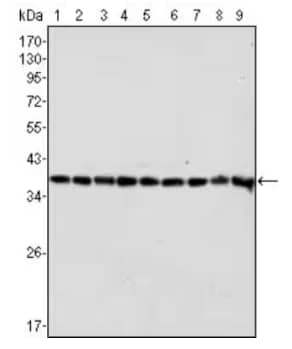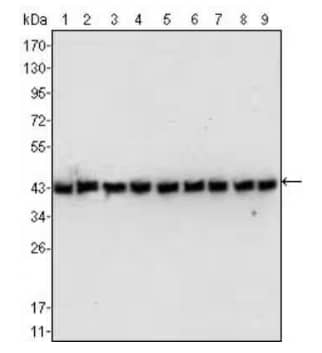Western blotting is an essential technique to probe protein expression in complex cell or tissue lysates. To accurately determine protein expression and interpret Western blot results, it is important to use loading controls. A loading control antibody helps determine if samples have been loaded equally across all wells and confirms effective protein transfer during the western blot protocol. When considering a loading control for your experiment, it is important to choose a protein that does not have a similar molecular weight to your target of interest. Additionally, the loading control protein should demonstrate ubiquitous expression. The most popular loading control targets include beta-actin and GAPDH.

GAPDH Antibody (1A10) [NBP1-47339] Western blot analysis using anti-GAPDH mAb against Hela (1), A549 (2), A431 (3), MCF-7 (4), K562 (5), Jurkat (6), HL60 (7), SKN-SH (8) and SKBR-3 (9) cell lysate.

| beta-Actin Antibody (8H10D10) [NBP1-47423] Western blot analysis using anti-Beta Actin mAb against NIH/3T3 (1), Jurkat (2), Hela (3), CHO (4), PC12 (5), HEK293 (6), COS (7), A549 (8) and MCF-7 (9) cell lysates. |
Beta-actin (42 kDa) is commonly chosen as a loading control due to its general expression across all eukaryotic cell types. The expression levels of this protein do not vary drastically due to cellular treatment, which is another reason the protein makes a suitable control. Bio-Techne offers a wide selection of highly characterized beta-actin antibodies.
GAPDH (36 kDa) is integral for glycolysis and plays many roles in nuclear function; such as transcription regulation and apoptosis. The stable and ubiquitous expression of GAPDH also make it a suitable loading control for many experiments. When using GAPDH as a loading control, it is important to keep in mind that its expression level does vary between tissues.